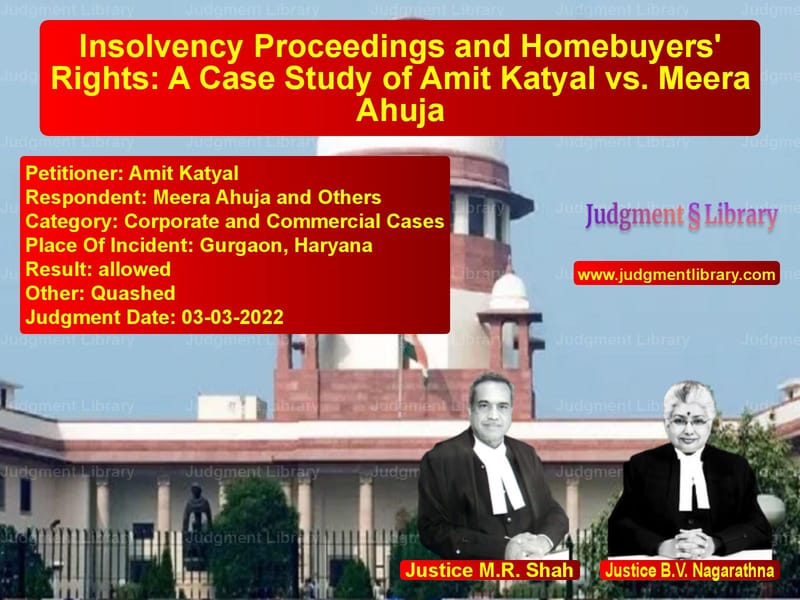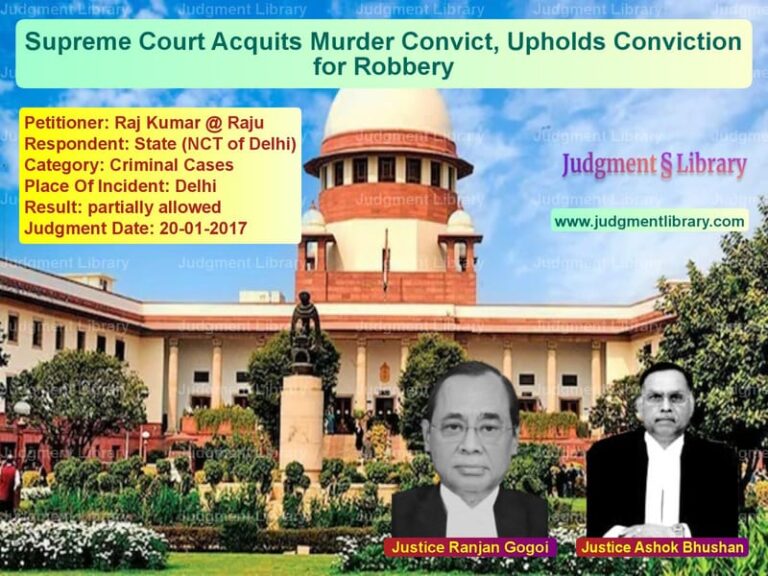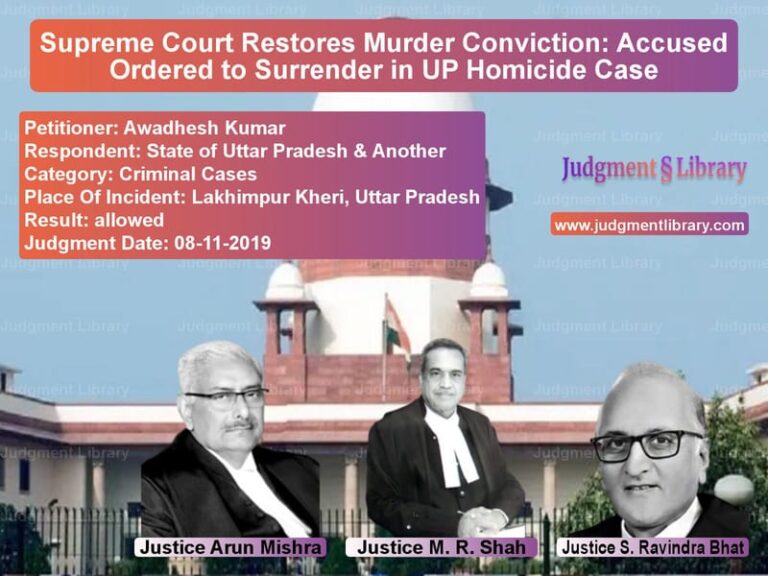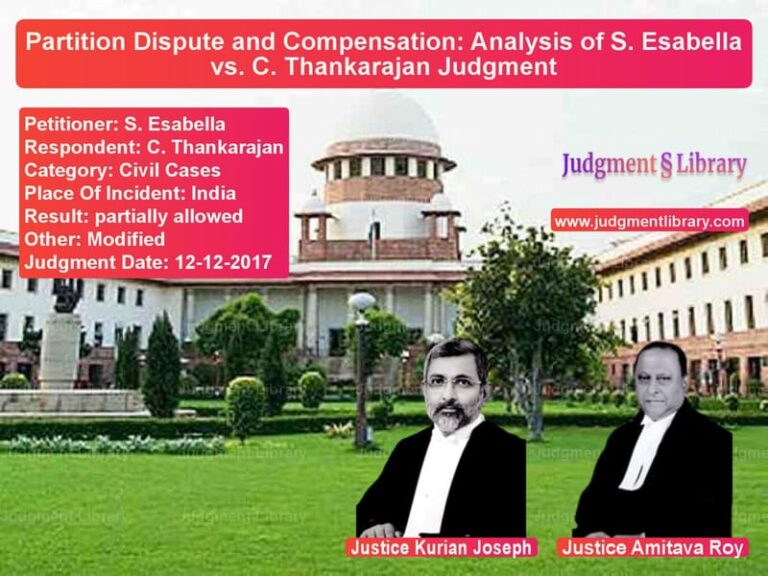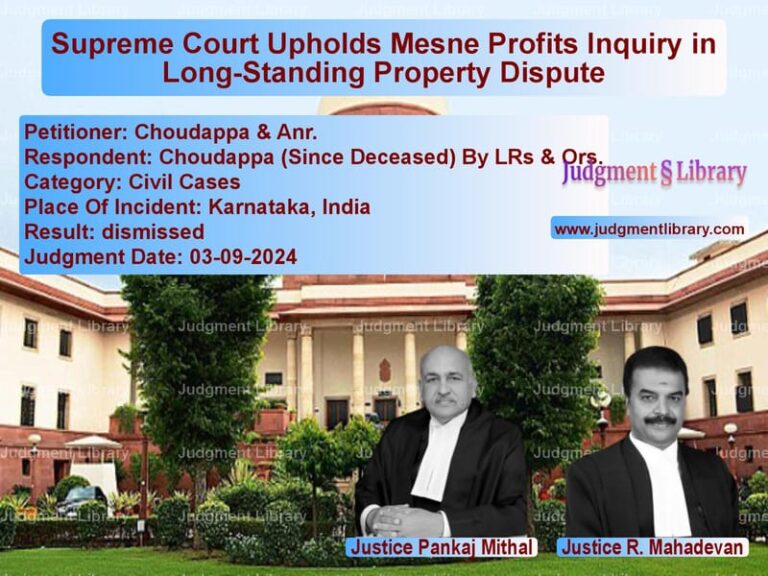Insolvency Proceedings and Homebuyers’ Rights: A Case Study of Amit Katyal vs. Meera Ahuja
The case of Amit Katyal vs. Meera Ahuja and Others sheds light on critical aspects of the Insolvency and Bankruptcy Code (IBC), 2016, particularly concerning homebuyers’ rights and the resolution process of stalled real estate projects. This case, which involved an appeal against the initiation of Corporate Insolvency Resolution Process (CIRP), underscores the importance of settlements in insolvency matters and the judiciary’s role in balancing the interests of all stakeholders.
Background of the Case
The dispute arose when the Corporate Debtor, Jasmine Buildmart Pvt. Ltd., failed to complete its Gurgaon-based housing project, Krrish Provence Estate, even after eight years. Frustrated by the delays, three homebuyers—Meera Ahuja and others—filed an application under Section 7 of the IBC, seeking to initiate insolvency proceedings against the Corporate Debtor.
The National Company Law Tribunal (NCLT), Delhi, admitted the application on 28.11.2019, appointed an Interim Resolution Professional (IRP), and declared a moratorium under Section 14 of the IBC. The appellant, Amit Katyal, a promoter and majority shareholder of Jasmine Buildmart Pvt. Ltd., challenged this order before the National Company Law Appellate Tribunal (NCLAT), arguing that the homebuyers’ claim could be settled outside the insolvency framework.
However, the NCLAT dismissed the appeal, affirming the NCLT’s decision. Dissatisfied with this outcome, the appellant approached the Supreme Court, contending that most homebuyers had agreed to a settlement and did not wish to proceed with CIRP.
Key Arguments Presented
Arguments by the Petitioner (Amit Katyal)
- The project was near completion, and homebuyers had been given an option to either take possession or claim a refund.
- Out of 128 homebuyers, 82 agreed to settle and withdraw the insolvency proceedings.
- The company had undertaken to complete the project within one year and hand over possession.
- The IRP had not taken significant steps in the CIRP process since the Committee of Creditors (COC) had not held its first meeting.
- Proceeding with insolvency would not serve homebuyers’ interests, as liquidation would lead to financial losses for all stakeholders.
Arguments by the Respondents (Homebuyers and Other Stakeholders)
- The homebuyers had waited for over eight years, and insolvency was the only way to ensure their investment was protected.
- The appellant had delayed completion multiple times, causing financial distress to homebuyers.
- Some homebuyers who did not opt for settlement wanted the insolvency process to continue.
- The IRP had already started the insolvency process, and halting it would disrupt the established framework.
Supreme Court’s Observations
The Supreme Court analyzed the case based on the facts presented, particularly emphasizing the rights of homebuyers under IBC. The Court noted:
“Out of 128 homebuyers, 82 homebuyers will get possession within a period of one year, as undertaken by the appellant and Corporate Debtor. The original applicants have also settled the dispute with the appellant/Corporate Debtor. We are of the opinion that this is a fit case to exercise the powers under Article 142 of the Constitution of India read with Rule 11 of the NCLT Rules, 2016, and permit the original applicants to withdraw the CIRP proceedings.”
The Court further observed that allowing the insolvency process to continue would negatively impact homebuyers. If CIRP proceeded, the moratorium under Section 14 of the IBC would stay all proceedings, preventing homebuyers from pursuing compensation claims. Additionally, if liquidation occurred, homebuyers—who are unsecured creditors—would likely receive significantly reduced payouts.
Final Judgment
The Supreme Court ruled in favor of the settlement, allowing the withdrawal of CIRP proceedings. Key points of the judgment included:
- Homebuyers who agreed to settlement would receive possession within a year.
- The corporate debtor (Jasmine Buildmart Pvt. Ltd.) was directed to complete the project.
- The company had to file an undertaking before the Court, ensuring compliance with the settlement terms.
- All pending insolvency proceedings against the company were dismissed.
- The Supreme Court directed the appellant to pay Rs. 6,00,000 to the IRP for expenses incurred.
Key Takeaways from the Judgment
- Homebuyers’ Rights Under IBC: The judgment reinforces the principle that insolvency proceedings should not be used in a manner that harms homebuyers’ interests.
- Settlement in Insolvency Cases: Courts have the discretion to permit settlement agreements even after insolvency proceedings have commenced, provided it serves a larger public interest.
- Article 142 of the Constitution: The Supreme Court exercised its special powers under Article 142 to ensure complete justice, overriding technical objections under the IBC framework.
- Importance of Timely Completion: The judgment highlights that insolvency should not be a tool for delaying construction but rather a last resort for ensuring accountability.
Conclusion
This case sets a precedent for handling insolvency proceedings in real estate matters. The Supreme Court demonstrated that while the IBC is a powerful tool for financial resolution, it must be applied with caution when dealing with homebuyers’ interests. By prioritizing project completion over liquidation, the Court ensured that those who had invested their hard-earned money did not suffer undue hardship.
Petitioner Name: Amit Katyal.Respondent Name: Meera Ahuja and Others.Judgment By: Justice M.R. Shah, Justice B.V. Nagarathna.Place Of Incident: Gurgaon, Haryana.Judgment Date: 03-03-2022.
Don’t miss out on the full details! Download the complete judgment in PDF format below and gain valuable insights instantly!
Download Judgment: amit-katyal-vs-meera-ahuja-and-othe-supreme-court-of-india-judgment-dated-03-03-2022.pdf
Directly Download Judgment: Directly download this Judgment
See all petitions in Bankruptcy and Insolvency
See all petitions in Company Law
See all petitions in Corporate Compliance
See all petitions in unfair trade practices
See all petitions in Shareholder Disputes
See all petitions in Judgment by Mukeshkumar Rasikbhai Shah
See all petitions in Judgment by B.V. Nagarathna
See all petitions in allowed
See all petitions in Quashed
See all petitions in supreme court of India judgments March 2022
See all petitions in 2022 judgments
See all posts in Corporate and Commercial Cases Category
See all allowed petitions in Corporate and Commercial Cases Category
See all Dismissed petitions in Corporate and Commercial Cases Category
See all partially allowed petitions in Corporate and Commercial Cases Category

